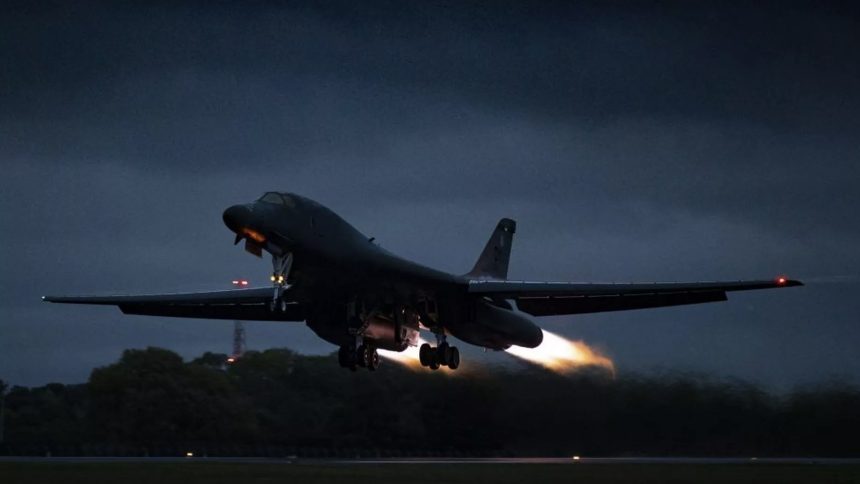Originally conceived as a supersonic long-range strategic nuclear heavy bomber, the B-1 has evolved into a very effective multi-role conventional warplane.
A product of the Cold War, the North American Rockwell B-1 bomber was conceived as a strategic nuclear deterrent, with a greater payload, range, survivability probability, and penetration capability than the mainstay of the United States Air Force (USAF) Strategic Air Command (SAC), the Boeing B-52.
Initially a Mach 2.2 design in the B-1A, and subsequently cancelled, the bomber was reimagined and resurrected as the Mach 1.25 B-1B with improved low-level penetration capabilities. Soviet air defenses continued to improve, and high-altitude aircraft were at risk, as proven by the earlier U-2 incident. Consequently the USAF shifted strategy to high subsonic speed low-level penetration attacks.
With the fall of the Soviet Union the nuclear role of the B-1 was soon ended, leading to the aircraft being converted for conventional roles, which the heavy bomber has become very adept at.
Development
The Advanced Manned Strategic Aircraft (AMSA) study began in 1965 lasting four years and revising the previous standards of the 1963 Advanced Manned Precision Strike System (AMPSS). Funded by the United States Air Force (USAF) and conducted by Boeing, North American Rockwell, and General Dynamics, the AMSA study’s official primary mission was to deter nuclear war. AMSA concluded the aircraft would need to have the ability to survive a first strike by the enemy, be able to successfully penetrate enemy defenses, and accurately deliver weapons, and do these things with a greater payload and range than the current B-52.

April 1969 saw the program designated the B-1A, following a new bomber designation series first created in 1962. In November 1969, the USAF issued Requests for Proposals (RFP), with all three companies involved in the AMSA study making submissions. North American Rockwell was selected in June 1970 as a development contractor.
The B-1A
North American Rockwell became Rockwell International in 1973, with the first B-1A rolling at Palmdale, California on Oct. 26, 1974. After extensive ground checks ,serial number 74-0158 made its maiden flight leaving Palmdale and flew for 78 minutes, landing at Edwards Air Force Base, California.
The first B-1A prototype had a length of 150 ft, with a height of 33 ft 7 in, and a wingspan of 136 ft 9 in when in the un-swept position. The aircraft’s variable-geometry wings provided increased smaller airfield options over the B-52, allowing the wings to produce more lift during takeoff and landing while in the widest forward position (15°), and produce lower drag while in the retracted position (67°)allowing for faster flight during the high-speed dash stages of missions at supersonic flight.
Power came from four General Electric F101-GE-100 turbofan afterburning engines. Air intake ramps and exhaust nozzles were variable, allowing for the high-altitude speeds of Mach 2.2 and low altitude Mach .85 speeds.
The B-1A had three weapons bays, capable of carrying up to 114,752 lb of stores, including the AGM-69A Short-Range Attack Missile (SRAM) as well as the new AGM-86 Air-Launched Cruise Missiles (ALCMs).
A crew of four would be housed in an escape capsule similar to that used in the General Dynamics F-111 that would allow the entire crew to be ejected in a pod in case of an emergency. The escape pod was included on the first three B-1As, with the fourth and final B-1A being fitted with conventional individual ejection seats.
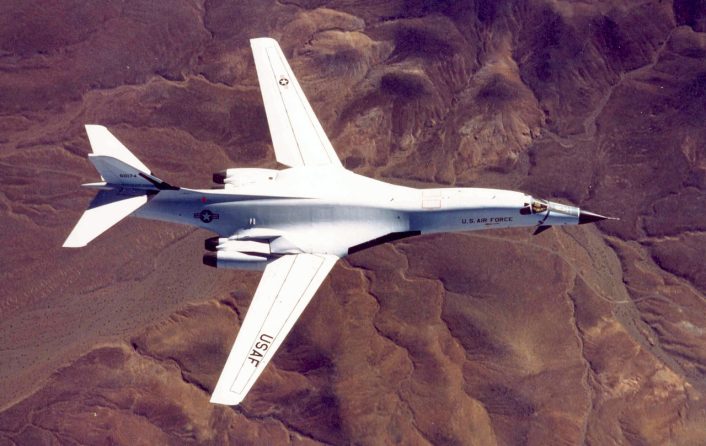
Painted anti-flash white, the first three B-1As were optimized for traditional high-altitude bombing and when conducting low-level runs, the white stood out against the earth below. The forth B-1A did receive a camouflage paint job, however in 1976 new information came to light that the Soviets had look-down/shoot-down radar technology, making aircraft flying low-level penetration missions vulnerable.
Believing the aircraft was vulnerable, and concerned the ever rising price tag per plane exceeding $100 million each, along with the B-52 being modernized to carry much of the same weaponry, and something in the works known later as the Advanced Technology Bomber (ATB) project, President Jimmy Carter cancelled the B-1 program in 1977. The four existing B-1A’s were allowed to continue testing however, with the second B-1A reaching a top speed of Mach 2.22.
Resurrected by Reagan: The B-1B
President Carter’s decision to cancel the B-1 program was controversial, and took many in the defense department by surprise. In 1979 the Soviets invaded Afghanistan and the Iranian hostage crisis was ongoing as well. Ronald Reagan campaigned for president on the platform of a strong defense, promising to reinstate the B-1 program. Reagan won in a landslide, and the Iranians released the hostages just minutes after Reagan was sworn in. The Soviet Union threat continued to loom large however.
Reagan decided to move forward with the B-1 program as an interim as it could be operational before the ATB bomber (B-2) was ready. The operational B-1 would be designated the B-1B and would have some differences with the previous B-1A version. Two B-1As would be modified with B-1B systems for testing.
A total of 100 B-1B ‘Lancers’ were constructed, with the first production B-1B flying on Oct. 18, 1984, the first aircraft delivered on June 29, 1985, and the final 100th example being delivered to the USAF in May 1988.
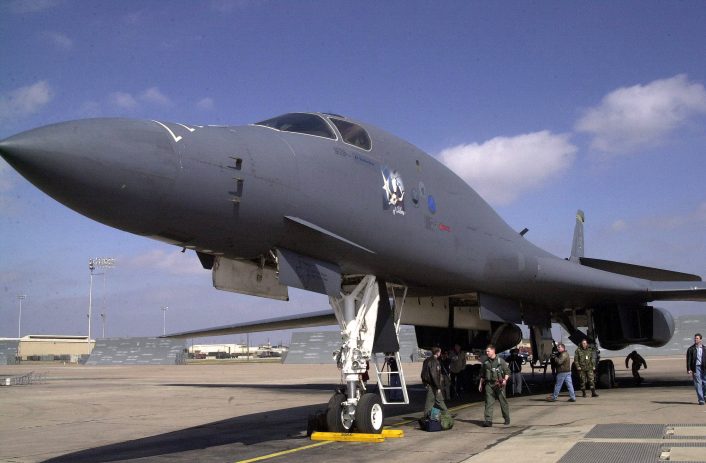
The B-1B maintained the individual ejection seats of the fourth B-1A in favor of the crew escape pod incorporated on the first three B-1As. The B-1B maintained the four man crew of its predecessor, including an aircraft commander, pilot, offensive systems officer, and defensive systems officer.
It was determined by earlier studies that the most successful method of penetrating enemy defenses was by subsonic low-altitude speeds over enemy territory coupled with supersonic high-altitude speeds for use while in transit over friendly or lightly defended areas.
With new avionics and now tuned more for low-level penetration at high subsonic speeds, the variable-aspect intake ramps were replaced with fixed geometry ramps, improving stealth characteristics of the aircraft. The trade-off was a lower maximum speed of Mach 1.25 at higher altitudes but low-level speeds increased to Mach .92.
The B-1B was fitted with the APQ-164 multimode radar instead of the APQ-144 scanning radar and the APQ-146 terrain-following radar of the B-1A. Upgrades in electronics improved the aircraft’s chances against Soviet look-down/shoot-down radar as well.
Maximum takeoff weight increased from 395,000 lbs to 477,000 lbs, allowing the bomber to takeoff with a full fuel load as well as more weapons to be carried, some external. The Lancer is capable of inflight refueling extending its range.
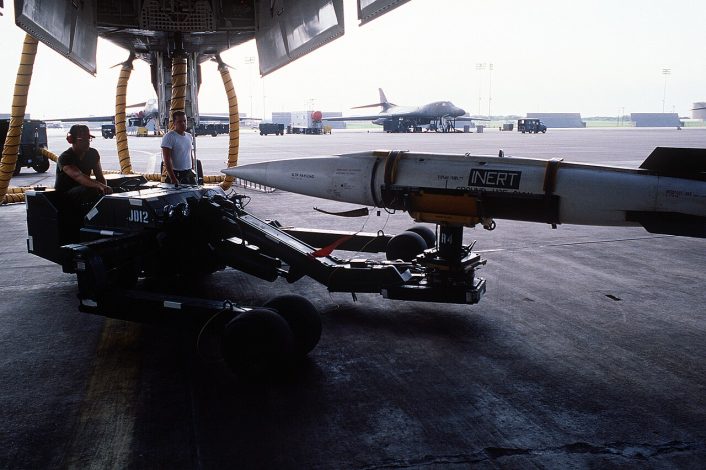
In the role of nuclear deterrence, the B-1B could carry a variety of loadings including AGM-69 SRAMs, AGM-86B ALCMs, and B28, B43, B61, and B83 free-fall nuclear bombs. Weapons could be fitted to the internal weapon bays, and/or attached externally. Only the internal bays were to be used for low-level attacks, as external stores increased radar signature.
Going Conventional
With the collapse of the Soviet Union in 1991, the B-1’s role as a nuclear deterrent was coming to an end. SAC was soon absorbed into the Air Combat Command (ACC) and the B-1s began to be refitted for a more conventional weapons capability. Some had been fitted to carry the 500 lb Mk-82 general purpose (GP) conventional bombs.
By 1995 the nuclear arming hardware was removed, followed by modifications preventing the bombers from carrying nuclear weapons. In 1996 Rockwell International sold its defense operations to Boeing, who is now the contractor for the B-1. By 2011 the B-1 fleet was fully converted to a conventional role and compliant with the New START (Strategic Arms Reduction Treaty) between the United States and Russia.
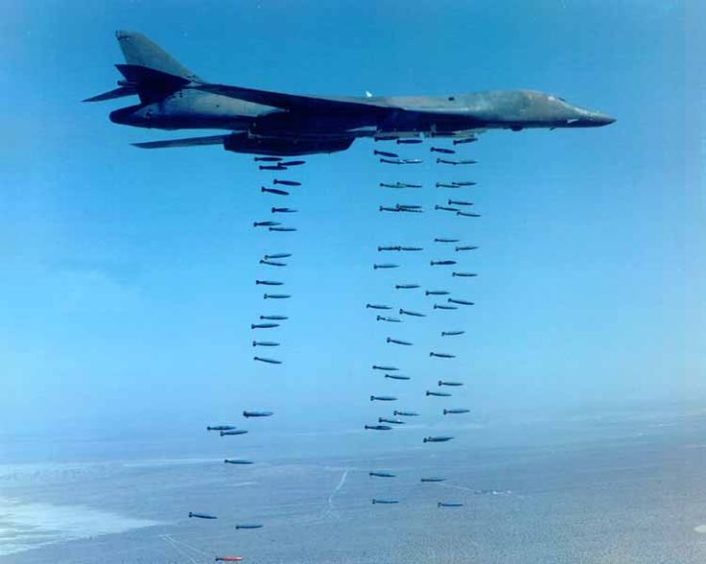
Staying on nuclear alert and other issues kept B-1B out of action during Operation Desert Storm, with the Bone (name derived from spelling out ‘B-One’ by the press minus the hyphen) first used in combat support operations during Operation Desert Fox in Iraq in December 1998. Unguided GP bombs were employed during this campaign. The B-1 was also used in Operation Allied Force in Kosovo.
Fitted with 2,000 lb GBU-31 JDAMs (Joint Direct Attack Munition), eight B-1s dropped close to 40 percent of the aerial ordinance during Operation Enduring Freedom in Afghanistan. 3,900 JDAMs were dropped during the operation by B-1s. JDAMs were also used by B-1s over Iraq during the Second Gulf War.
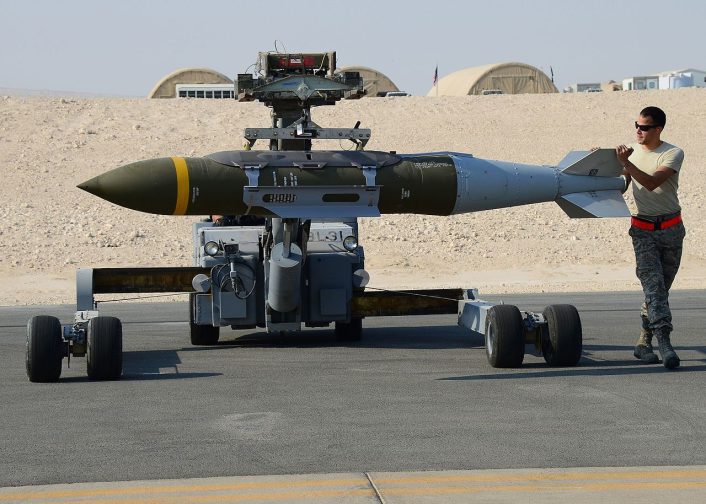
The JDAM system uses an integrated internal guidance system in conjunction with GPS (Global Positioning System) and can be fitted to unguided gravity bombs from 500 to 5,000 lbs. turning them into precision guided munitions (PGMs). They are described as able to hit within tens of feet of a target.
B-1s began performing ‘armed overwatch’ roles in 2008 by loitering over troubled areas of Iraq and Afghanistan. The Sniper Advanced Targeting Pod (ATP) permitted the aircraft to strike individual vehicles with extreme accuracy while flying surveillance missions loaded with guided bombs in support of ground troops. The Sniper utilizes positive identification, automatic tracking, and laser designation.
B-1s also dropped conventional munitions during Operation Odyssey Dawn over Libya in 2011, as well as being utilized during Operation Inherent Resolve against ISIS during the Syrian Civil War beginning in 2014, dropping over 2,000 JDAMs.
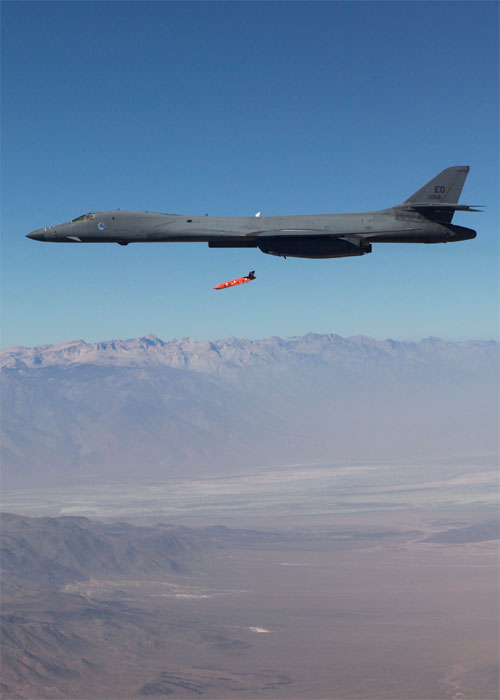
Two B-1s fired 19 JASSMs (Joint Air-to-Surface Standoff Missile) in April 2018 against Syrian targets in response to a chemical attack on April 7 against civilians. The JASSM AGM-158 (Air-to-Ground Missile) is a large, long-range, stealthy cruise missile with a 1,000 lb warhead capable of being carried and launched from the B-1. The AGM-158C LRASM (Long Range Anti-Ship Missile) is a derivative of the AGM-158B developed as a stealth anti-ship cruise missile that can also be carried by the B-1.
These weapons currently give the remaining B-1 fleet of 45 aircraft the capability to strike targets on land and at sea by launching hundreds of miles from the targets and hitting them with precision. A B-1 can carry up to 24 of these standoff weapons. It is planned that B-1s armed with these missiles will help facilitate the transition to the new B-21 Raider bomber.
The B-1 continued to be deployed against targets in the Middle East when in February of 2024, two were used to strike seven terrorist targets in Iraq and Syria in response to the killing of United States troops by a drone attack in Jordan.
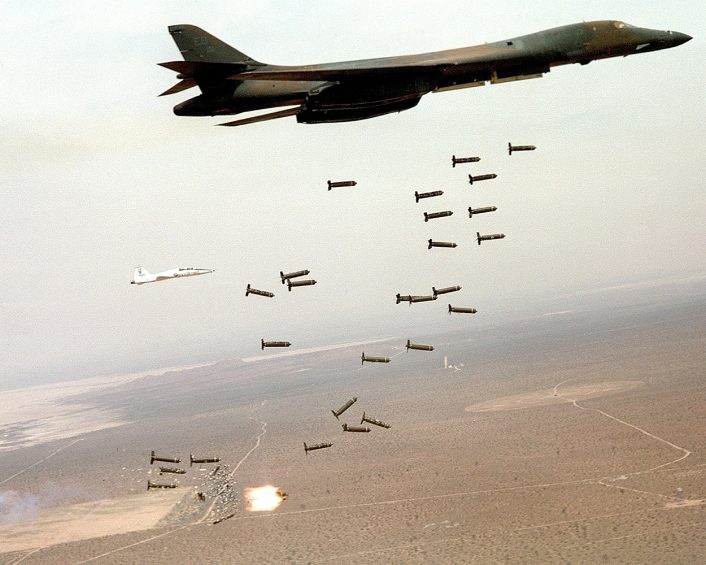
Boeing has developed a new pylon system for the B-1, known as the Load Adaptable Modular (LAM) pylon. Already tested on a B-1 in 2024, this pylon will allow the bomber to carry externally a variety of newer and heavier weapons, each plane carrying up to six of the pylons attached to external hardpoints. The pylons can accommodate two 2,000 lb or one 5,000 lb weapon.
It is possible the GBU-72/B 5,000 lb “Bunker Buster” may be one weapon carried using the LAM, and there is talk of hypersonic systems being carried and tested utilizing the new pods as well. This upgrade should extend the lifespan of the Lancer as well as insure it is effective today and into the future as a conventional bomber, even though it was not originally designed for the role.

